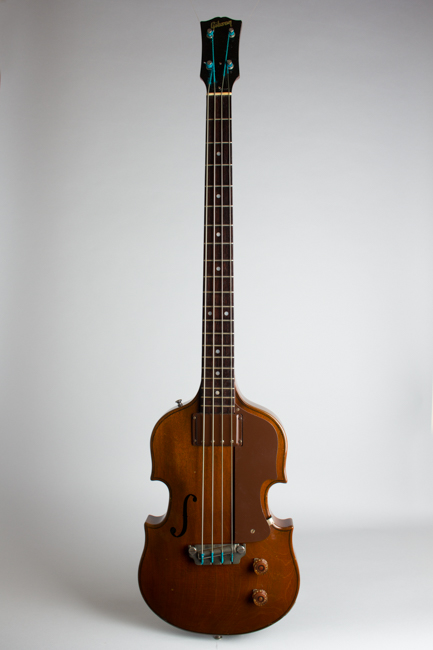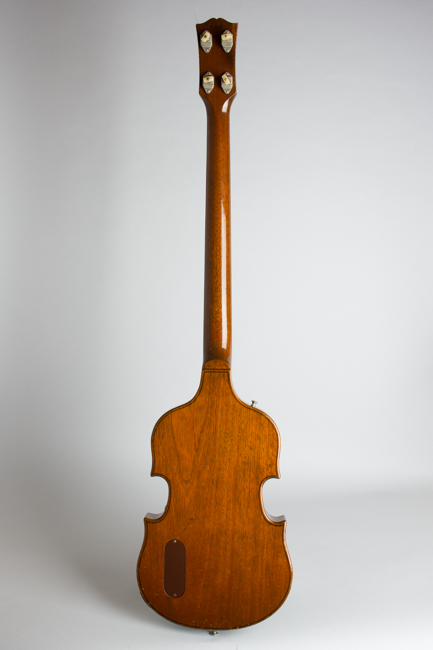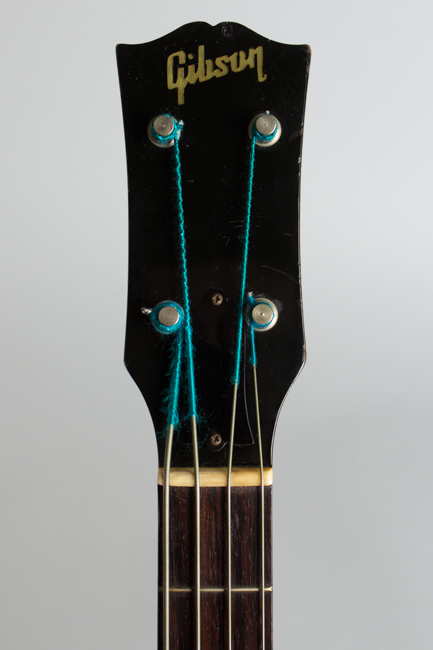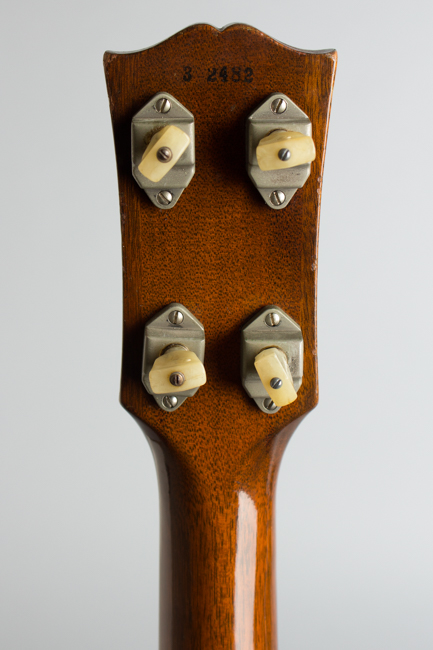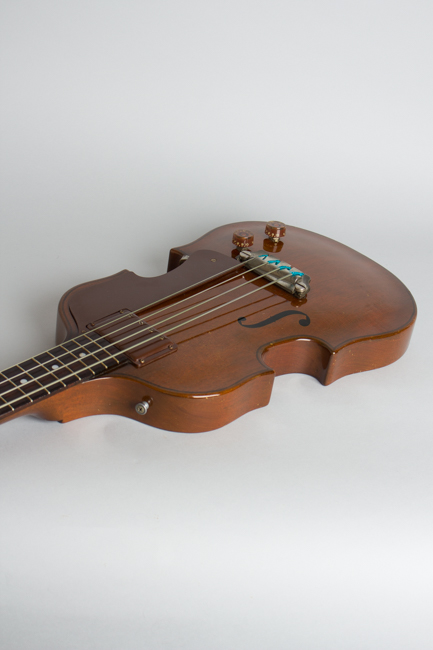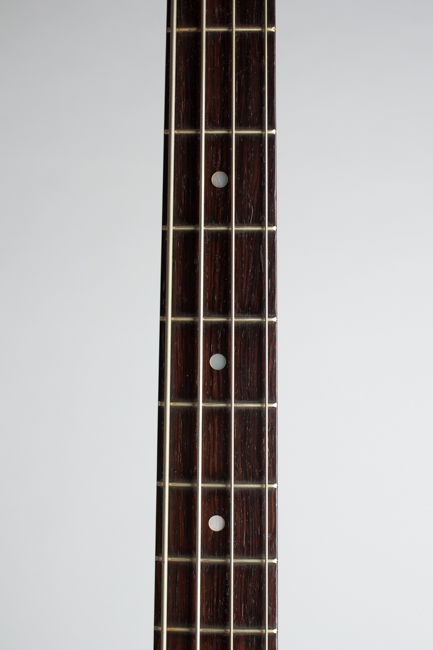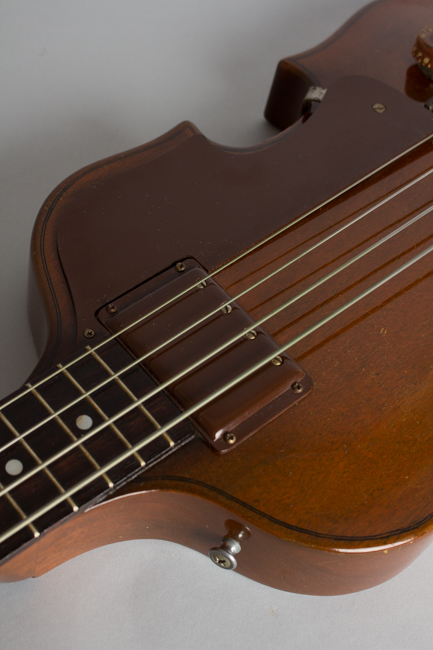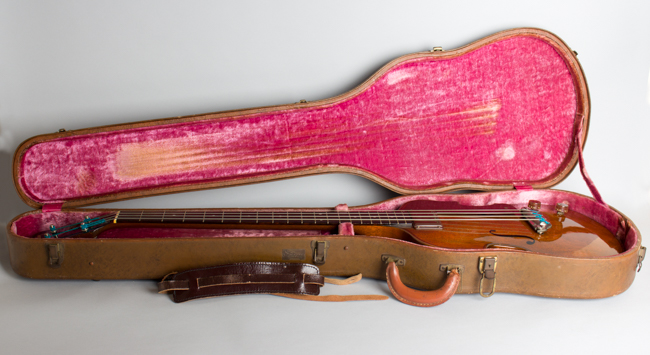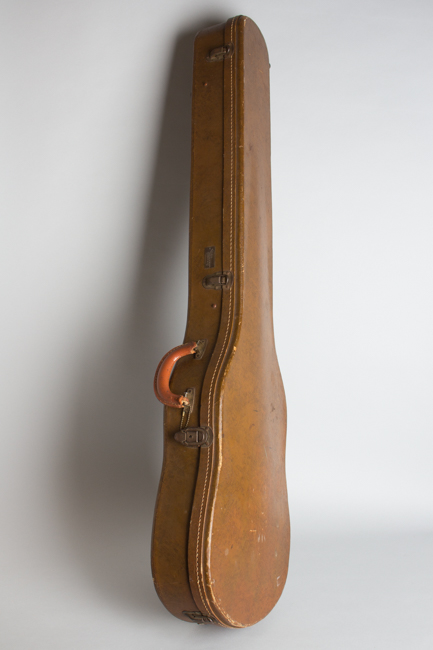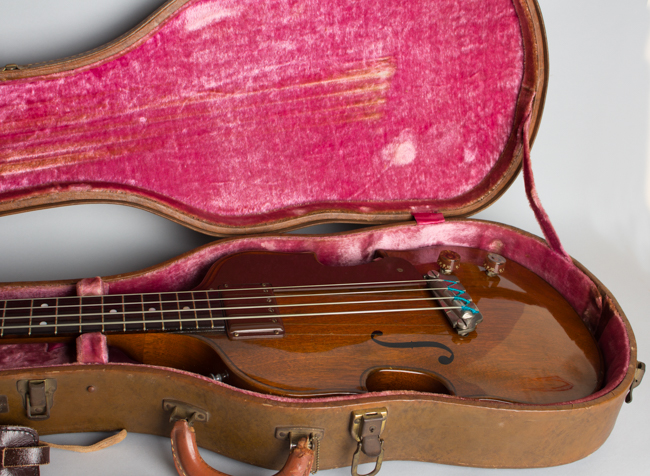Gibson EB-1 Electric Bass Guitar (1953)
This item has been sold.
Item # 8224
Prices subject to change without notice.
Gibson EB-1 Model Electric Bass Guitar (1953), made in Kalamazoo, Michigan, serial # 3-2482, natural mahogany finish, mahogany body and neck, rosewood fingerboard, original brown hard shell case.
We think this is just about the coolest and most distinctive electric bass ever designed -- and one of the most eccentric! The "Gibson Electric Bass" (The EB-1 name was not used until 1958, when the semi-hollow EB-2 debuted) was first issued in mid-1953 and is one of the earliest solid-body basses. The "fiddle-shaped" body design is unique and owes nothing but general concept to the slightly earlier (late 1951) Fender Precision -- and was likely an inspiration to Hofner in Germany! Gibson president Ted McCarty wanted something that was as different from the Fender Bass as possible, and that's what the company delivered.
The violin-body EBs were introduced in mid-1953, heralded as "a revelation in rhythm" by Gibson's sales department. This particular bass has a serial number dating to the mid-1953 period, marking it one of the very first of the new model ever issued. The EB sold all of 105 units that first year and the model was produced in fairly small numbers from 1953 through '58, when they were replaced by the simpler slab-bodied EB-0. Gibson's sales records indicate a total of 546 sold.
These early EB-1s are generally the clearest-sounding of the 30" scale Gibson basses. The large brown Royalite-covered pickup is actually a single coil unit; the huge coil is mounted on its side, which is why the polepieces sit at the bottom end. While still very powerful and deep-sounding, this pickup has more mid/high content than the 1958 and later humbucking versions.
The sculpted solid mahogany body has painted-on f-holes and "purfling" like a violin-family instrument, and a large (and seemingly superfluous) brown Royalite pickguard. Even the knobs and jackplate are tinted brown. The tuners at the top of the 30 1/2" scale mahogany neck are Kluson banjo units with keystone plastic buttons -- an odd choice Gibson persisted with up through 1960.
The Gibson Electric Bass has remained a connoisseur's oddity since its introduction. Although seen during the 1950s in the hands of the Flamingos, jump blues bandleader Lloyd Lambert, and most visibly Little Richard's Upsetters, the instrument never caught on in a big way.
In later years Felix Pappalardi, Jack Bruce, Doug Lubhan, and even (on occasion) John Paul Jones have made use of the Gibson EB, and it remains one of the company's most distinctive creations -- even if seeming a bit whimsical in retrospect. This very early model is as fine an example as we have ever had, complete in the original pink-lined brown HSC.
Overall length is 44 1/4 in. (112.4 cm.), 11 1/4 in. (28.6 cm.) wide at lower bout, and 1 3/4 in. (4.4 cm.) deep. Scale length is 30 1/2 in. (775 mm.). Width of nut is 1 11/16 in. (43 mm.).
This bass is very clean for its era, with some light wear but no damage or alterations. It remains 100% stock; even the fragile original brown plastic jack plate is still in place, and although it looks to have a crack on one side, it is still intact. There are small dings and dents to the finish, some belt buckle marks on the back into but not through the lacquer, and one small filled chip to the top face edge of the headstock.
Everything works as intended, and the original case is fully intact -- the only thing missing is the screw-in extendable post designed to allow stand-up play. The frets show hardly any wear, and it is set up with a set of real vintage flatwound strings that appear at least 40 years old and still sound great. A really nice example of a rare and historic bass; one of the very first Gibson bass guitars ever made. Excellent Condition.
We think this is just about the coolest and most distinctive electric bass ever designed -- and one of the most eccentric! The "Gibson Electric Bass" (The EB-1 name was not used until 1958, when the semi-hollow EB-2 debuted) was first issued in mid-1953 and is one of the earliest solid-body basses. The "fiddle-shaped" body design is unique and owes nothing but general concept to the slightly earlier (late 1951) Fender Precision -- and was likely an inspiration to Hofner in Germany! Gibson president Ted McCarty wanted something that was as different from the Fender Bass as possible, and that's what the company delivered.
The violin-body EBs were introduced in mid-1953, heralded as "a revelation in rhythm" by Gibson's sales department. This particular bass has a serial number dating to the mid-1953 period, marking it one of the very first of the new model ever issued. The EB sold all of 105 units that first year and the model was produced in fairly small numbers from 1953 through '58, when they were replaced by the simpler slab-bodied EB-0. Gibson's sales records indicate a total of 546 sold.
These early EB-1s are generally the clearest-sounding of the 30" scale Gibson basses. The large brown Royalite-covered pickup is actually a single coil unit; the huge coil is mounted on its side, which is why the polepieces sit at the bottom end. While still very powerful and deep-sounding, this pickup has more mid/high content than the 1958 and later humbucking versions.
The sculpted solid mahogany body has painted-on f-holes and "purfling" like a violin-family instrument, and a large (and seemingly superfluous) brown Royalite pickguard. Even the knobs and jackplate are tinted brown. The tuners at the top of the 30 1/2" scale mahogany neck are Kluson banjo units with keystone plastic buttons -- an odd choice Gibson persisted with up through 1960.
The Gibson Electric Bass has remained a connoisseur's oddity since its introduction. Although seen during the 1950s in the hands of the Flamingos, jump blues bandleader Lloyd Lambert, and most visibly Little Richard's Upsetters, the instrument never caught on in a big way.
In later years Felix Pappalardi, Jack Bruce, Doug Lubhan, and even (on occasion) John Paul Jones have made use of the Gibson EB, and it remains one of the company's most distinctive creations -- even if seeming a bit whimsical in retrospect. This very early model is as fine an example as we have ever had, complete in the original pink-lined brown HSC.
Overall length is 44 1/4 in. (112.4 cm.), 11 1/4 in. (28.6 cm.) wide at lower bout, and 1 3/4 in. (4.4 cm.) deep. Scale length is 30 1/2 in. (775 mm.). Width of nut is 1 11/16 in. (43 mm.).
This bass is very clean for its era, with some light wear but no damage or alterations. It remains 100% stock; even the fragile original brown plastic jack plate is still in place, and although it looks to have a crack on one side, it is still intact. There are small dings and dents to the finish, some belt buckle marks on the back into but not through the lacquer, and one small filled chip to the top face edge of the headstock.
Everything works as intended, and the original case is fully intact -- the only thing missing is the screw-in extendable post designed to allow stand-up play. The frets show hardly any wear, and it is set up with a set of real vintage flatwound strings that appear at least 40 years old and still sound great. A really nice example of a rare and historic bass; one of the very first Gibson bass guitars ever made. Excellent Condition.
